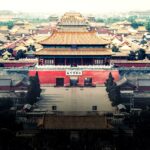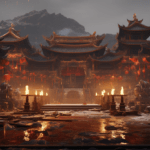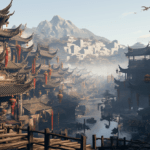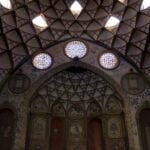Step into a world of opulence and grandeur as we unveil the hidden splendor of Han Dynasty Golden Age Architecture. In this captivating article, we invite you to embark on a journey through time, exploring the magnificent structures that defined a prosperous era. Prepare to be enchanted by the intricate designs, exquisite craftsmanship, and cultural significance that are woven into the very fabric of these golden age treasures. Join us as we delve into the depths of this ancient architectural legacy, unlocking the secrets that have captivated historians and enthusiasts alike for centuries.
Han Dynasty Golden Age Architecture
During the Han Dynasty, China experienced a golden age that left a lasting impact on Chinese civilization. The architectural achievements of this era reflect the grandeur and sophistication of the time. As a seasoned architectural historian and writer, I am thrilled to delve into the world of Han Dynasty golden age architecture and reveal its splendor.
The Han Dynasty, established by Liu Bang and ruled by the House of Liu, was an imperial dynasty that held the emperor as the highest position in society and government. Under the guidance of a regent, the emperor’s rule shaped the architectural landscape of the dynasty.
Architects during the Han Dynasty displayed remarkable skill in the construction of various structures. They designed and built magnificent watchtowers, palaces, temples, and storehouses. These structures were not only functional but also carried symbolic and cultural significance. Each edifice was a testament to the mastery and artistic prowess of the Han Dynasty architects.
The scientific and technological advancements of the era influenced architectural techniques and materials. The Han Dynasty architects employed innovative methods and utilized new materials to create structures that were aesthetically pleasing, structurally sound, and resistant to the test of time. This combination of artistic creativity and technical expertise resulted in architectural marvels that continue to captivate us today.
Intricate details and decorative elements were paramount in Han Dynasty architecture. The meticulous craftsmanship and attention to detail in intricate carvings, sculptures, and paintings showcased the expertise and artistry of the architects. These details not only added beauty to the structures but also conveyed symbolic meanings that resonated with the cultural and philosophical values of the dynasty.
The harmony between architecture and nature was another hallmark of Han Dynasty golden age architecture. Architects carefully chose locations for buildings that embraced the natural surroundings, incorporating elements such as gardens, courtyards, and water features into their designs. This integration of man-made structures with the natural environment created a serene and harmonious atmosphere, inviting visitors to immerse themselves in the beauty of nature.
The Han dynasty’s promotion of Confucianism had a profound influence on architectural design. Confucian ideals of filial piety and respect for tradition and ancestors shaped the layout and organization of buildings. The family structure was central to Han society, and architectural designs reflected this emphasis on family unity and filial piety. Multiple generations often lived under one roof, and houses were designed to accommodate the nuclear family while fostering a sense of communal living.
The Han Dynasty’s architectural legacy extended beyond its borders. The opening of the Silk Road trade route brought cultural exchange and new influences that impacted architectural styles. The fusion of different architectural techniques and designs from diverse regions created a rich tapestry of styles that characterized the golden age of Han Dynasty architecture.
In conclusion, Han Dynasty golden age architecture stands as a testament to the creativity, expertise, and artistic finesse of the era. The grand structures, intricate details, and harmonious integration with nature showcase the brilliance and cultural significance of this remarkable period. By unraveling the splendor of Han Dynasty golden age architecture, we gain a deeper understanding of the rich heritage and enduring legacy left by this golden age in Chinese history.
“From the grand palaces to the smallest decorative details, Han Dynasty golden age architecture reveals a world of majestic beauty and cultural significance.”
The Han Dynasty golden age was a time of great prosperity and advancement in ancient China. The empire experienced unprecedented economic growth, cultural flourishing, and innovative achievements. The rulers of the Han Dynasty implemented effective governance and encouraged intellectual pursuits, resulting in numerous inventions such as paper, compass, and seismograph. To learn more about the fascinating era of the Han Dynasty golden age, click here: han dynasty golden age.
How the Tang Dynasty of China Established Dominance in East and Central Asia
[youtube v=”MOVlzodPQUc”]
Han Dynasty’s Lasting Impact on Architecture during the Tang Dynasty
The Han Dynasty marked a golden age in Chinese civilization, leaving a lasting impact on the architectural landscape. Architects during the Tang Dynasty showcased exceptional skill and artistry in constructing structures that were both functional and visually significant. Watchtowers, palaces, temples, and storehouses were among the remarkable structures created during this time.
“Architecture during the Tang Dynasty displayed a perfect amalgamation of functionality and artistic prowess, leaving behind an enduring legacy.”
Innovative Techniques and Artistic Significance
Tang Dynasty architects employed innovative techniques and utilized new materials to create structures that were not only aesthetically pleasing but also durable. Intricate carvings, sculptures, and paintings adorned these buildings, demonstrating the craftsmanship of the architects.
“The Tang Dynasty witnessed the rise of architectural innovation, as architects pushed the boundaries of construction techniques and utilized new materials to create stunning structures.”
Harmony with Nature in Tang Dynasty Architecture
One notable aspect of Tang Dynasty architecture was its integration with the natural environment. Architects incorporated elements such as gardens, courtyards, and water features, seamlessly blending man-made structures with nature.
“Tang Dynasty architects sought to harmonize human creations with the natural world, resulting in architecture that blended seamlessly with the surrounding environment.”
Influence of Confucian Ideals on Tang Dynasty Architecture
Confucian ideals heavily influenced the layout and organization of buildings during the Tang Dynasty. The emphasis on family unity and filial piety was reflected in the architectural design, creating spaces that fostered these values.
“The principles of Confucianism played a significant role in shaping Tang Dynasty architecture, with buildings designed to promote family unity and filial piety.”
Cultural Exchange and Influence from the Silk Road
The opening of the Silk Road trade route brought new influences and cultural exchange, impacting architectural styles during the Tang Dynasty. The exchange of ideas and materials from different regions enriched the architectural landscape of China.
“The vast trade network of the Silk Road facilitated a cultural exchange, influencing architectural styles and bringing new ideas, materials, and design elements to the Tang Dynasty.”
Tang Dynasty Architecture: A Symbol of Creativity and Cultural Significance
The architectural achievements of the Tang Dynasty represent a golden age of creativity, expertise, and cultural significance. The structures built during this time continue to be admired for their artistic excellence and lasting impact on Chinese architecture.
“Tang Dynasty architecture stands as a testament to the ingenuity and cultural significance of this prosperous era, showcasing the creativity and expertise of its architects.”
FAQ
Q: What is the significance of the Han Dynasty in Chinese history?
A: The Han Dynasty is considered a golden age in Chinese history and has greatly influenced Chinese civilization to this day.
Q: Who were the ruling family of the Han Dynasty?
A: The ruling family of the Han Dynasty was the House of Liu, established by Liu Bang.
Q: What types of structures were built during the Han Dynasty?
A: Architects during the Han Dynasty built various structures, including watchtowers, palaces, temples, and storehouses.
Q: What was the family structure like during the Han Dynasty?
A: The Han Dynasty had a patrilineal family structure, with several nuclear family members typically living in one household.
Q: What were some key advancements in science and technology during the Han Dynasty?
A: The Han Dynasty was known for its significant advancements in science and technology, which contributed to the progress of Chinese civilization.
- Senior at What Age: Benefits & Eligibility Guide - March 29, 2025
- Unlocking Senior Benefits: How Old is a Senior? Your Complete Guide - March 29, 2025
- Master Russian Politeness:A Guide to Saying Please - March 29, 2025
















